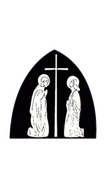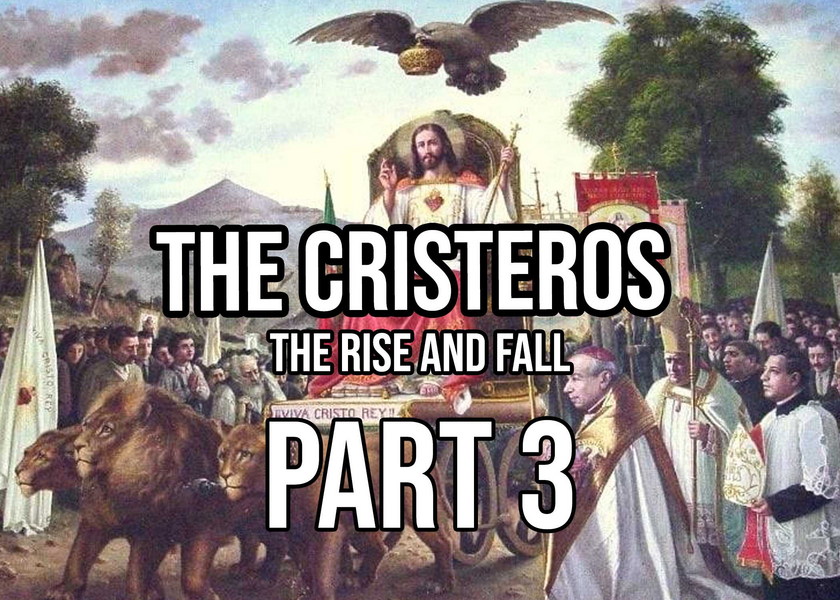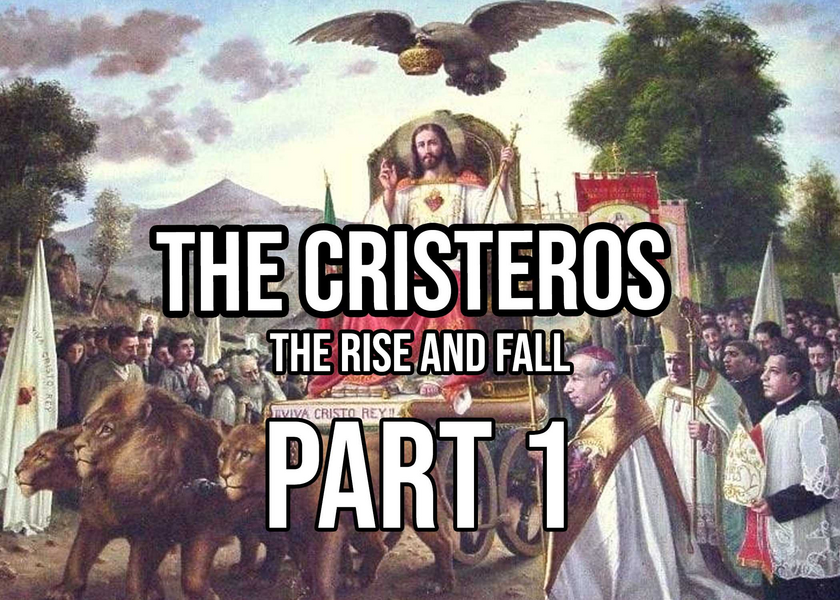Chapter 2
The Rise of the Cristeros
By Mark Fellows
“The Torch of Faith flickers, the sign of redemption is hidden, and the cries of the impious suffocate the voices of good men and the clamor of religion. Save us Lord, for we are dying!” Mexican Bishop Ruiz y Flores, a published prayer prayed on the last day of religious services in Mexico, July, 1926.
The 1857 Laws of Reform sought to separate the Church in Mexico from the State. The 1917 Constitution sought to subordinate the Church to the State. Some congressmen used extravagant rhetoric to justify this progression.
“The clergy is the most dismal, most perverse enemy of the fatherland! shouted Francisco J. Mugica, who had once been expelled from the Zamora Seminary…for these new and angry Jacobins, the Church was a den of thieves, outlaws, con men…
“A man named Recio from Yucatan proposed that confession be constitutionally prohibited, while delegate Alonso Romero elaborated a multiple image of the woman at confession as an adulteress, the priests as satyrs, and the husbands - who would allow their wives to pour the secrets of home into the licentious ears of priests - as pimps.”[1]
Minority opposition to the new Constitution predicted the radicals would not be content
“with smashing the images of the Saints, pulling the rosaries to pieces, tearing down the crucifixes, getting rid of Novenas and suchlike frivolities, shutting the door against priests, and abolishing freedom of association so that nobody can go to Church to make contact with the clergy...
“It should destroy religious freedom altogether, and after that, in an orgy of sated intolerance, they (radicals) will be able to promulgate this one article: in the Mexican Republic there will only be guarantees for those who think as we do.”[2]
Strict enforcement of the Constitution would have made it nearly impossible for the Church to operate. It mandated secular education in all schools, prohibited religious vows, religious orders, and religious instruction. It would have forbade public worship and made it legally impossible for the Church to own property. The constitutional article that caused the most opposition was Article 130. A secular historian writes:
“It effectively reduced the clergy to second class status, and was one of the most openly restrictive laws against a single group of citizens enacted in modern times. Clergy were denied such basic liberties as the right to vote, to hold office, to criticize public officials, or to comment on public affairs in religious periodicals.
“The Church was denied a juridical personality, state legislatures were empowered to regulate the number of clergy allowed to practice in their states, and jury trial was denied in cases relating to violations of the articles.”[3]
Resistance
Opposition to the new Constitution was widespread and took many forms: passive resistance, active resistance (with bloodshed and death), and economic boycotts of Masonic and government businesses. The boycotts, which were very effective in central Mexico, were organized by various Catholic Action associations. The most prominent organization was the National League for the Defense of Religious Liberty (known as the Liga).
The Liga initially had the blessing of the Mexican episcopate, but as events escalated the Liga began advocating open warfare. The Liga’s encouragement of the Cristeros caused the majority of the Mexican episcopate (and Pope Pius XI) to withdraw their blessing, leaving the Liga a suspect organization in the eyes of many Mexican Catholics.
Another Catholic Action organization was Union Popular (UP). Its leader, Anacleto Gonzalez Flores, was as opposed to violence as the Liga was disposed to it. A lawyer and a layman, Flores organized peaceful boycotts in the state of Jalisco that crushed Masonic and government friendly businesses, including an anti-Catholic newspaper. Flores asked for a ban on eating meat, and butchers went out of business. Flores asked citizens to use candles at night, and the local electrical plant was forced to suspend operation. Even children joined the boycotts, mortifying themselves and ice cream vendors on hot days by demanding to see the vendor’s UP card before making a purchase.
Although effective on a local level, the boycotts did not change the government’s anti-clerical policies. Ironically, some of the more vocal opponents to Catholic boycotts were wealthy Catholics. This frustrated Flores, who believed that “If we really knew how to act as Catholics, we could make our enemies die of hunger.”[4] Committed to non-violent resistance, the man known as El Maestro believed martyrdom could change history:
“The offering of a martyr will never perish…The sacrifice of martyrs has written pages in history that will remain there forever. He (the martyr) has touched the living flesh of future generations and every day performs the miracle of reviving our spirits through the shedding of his blood…
“The martyr is and always has been the first citizen of a strange and unforeseen democracy who, in violent times, sacrifices his life so that his offering or his memory will never be extinguished.”[5]
Flores’ words prophesied his own life two years later. There would be many non-violent martyrs in Mexico besides Flores and Padre Pro. There were many others who could not in conscience allow evil to run free. Love of the Church and hatred of the Revolution united in a stream of passion that cried: “Better to die than deny Christ the King, without fearing martyrdom or death, in whatever form it might come! Sons, do not be cowards! Up and defend a just cause!”[6]
Women prayed inside the Guadalupe Sanctuary in Guadalajara while outside their husbands chanted “Viva Cristo Rey!” and “Viva la Virgen de Guadalupe!” Undaunted by scoffers, the men began demanding that passersby doff their hats and shout “Viva Cristo Rey!” Truckloads of troops arrived to break things up and the Catholics fired back. When a soldier entered the Sanctuary and began shooting at a statue of the Virgin of Guadalupe, a Catholic maiden stabbed him to death.[7]
Archbishop Leopoldo Ruiz y Flores, a bishop in the Central Mexican state of Michoacan, exhorted Catholics to non-violent resistance:
“(The Catholic Faith) must awaken in the soul such a love of Christ that, like the Apostles, we are disposed to build His Kingdom even at the cost of our own lives, and that, like the martyrs, we are prepared to lose everything before committing apostasy…
“Nothing will be able, as St. Paul says, to separate us from Christ. With His love reigning in us, in this world we shall reign with Him, because we shall know how to overcome all that would subjugate us.”[8]
Eloquent words indeed, but difficult to apply in episodes of heated human conflict, like when a group of two hundred Catholics protested their local government’s refusal to forward their petitions against the 1917 Constitution. A captain drew his gun and fired, then was attacked by the crowd and killed. His troops opened fire. Were the corpses laying on the streets non-violent protestors? Did it make a difference?
The Calles Law
The Revolution was a juggernaut that could be stalled by Catholic Action but not derailed. Organized resistance slowed the secular tide but could not reverse it. Areas of Mexico that offered token resistance were steamrolled by enforcement of the 1917 Constitution.
The most rigourous application was by Governor Garrido Canabal of Tabasco. All the churches were closed, then either destroyed or converted to government use. The bishops were deported. Only married priests were legally allowed to reside in Tabasco, which of course disqualified all priests.
Homes were stripped of all religious images. A law was passed requiring the eating of meat on Christian fast days. Celebration of Christmas was banned. Canabal’s enforcers were known as the Red Shirts. Upon saluting their leader he asked them, “Does God exist?”, and they replied, “He has never existed.” American businessman John W. Dulles observed:
“At an exhibition of livestock a fine bull on exhibit would be called ’God,’ a donkey named ’Christ,’ a cow named ’The Virgin of Guadalupe,’ an ox named ’The Pope,’ a hog named ’The Archbishop,’ etc…
“Among the children of the dictator was a son named Lenin and a daughter named Zoila Libertad (I am Liberty), a name which at one time provoked the saying that the only liberty existing in Tabasco was the daughter of Garrido - who was sometimes accompanied by a nephew named Luzbel (Lucifer).”[9]
When Plutarco Calles became President of the Mexican Republic he applied the 1917 Constitution to all of Mexico, despite opposition from virtually all the country’s citizenry. Bishop Mora y del Rio declared a Catholic campaign would work to repeal those parts of the Constitution the Church considered unjust, adding: “We cannot for any reason change this position without betraying our Faith and our Religion.”[10]
Working peacefully to change unjust laws was hardly an inflammatory idea, particularly since the 1917 Constitution explicitly stated it could be reformed. Yet Del Rio’s statement deeply offended President Calles, who was “so violent on the religious question that he lost his temper every time anyone mentioned the subject in his presence.” The Turk was
“a malignant and implacable enemy of the Roman Catholic Church…he has resolved to exterminate the Catholic Faith from Mexico…(he) possessed an energy which did not stop short of obstinacy and cruelty…
“He was prepared to attack not only persons but also principles and even the institution itself…(He) condemned as economically and politically disastrous the very existence of the Church.”[11]
Calles passed a series of self titled laws making it a criminal offense (five years in prison) for a priest to criticize the government or attempt to instruct Catholics (or non-Catholics) in the faith. The Calles Law also required all parish priests to register with the government or have their churches closed, a regulation helping the government regulate downward the number of priests in a given area.
The Calles laws gave the government almost complete control over the lives of priests. Copycat laws sprang up; one statute listed “harmful elements” of society that were subject to “security measures” as “the insane, degenerates, drug users, alcoholics, professional beggars, prostitutes, priests, and homosexuals.”[12]
Calles later admitted he was intentionally provoking the Church.[13] It worked. The First clash came in Mexico City, where priests ignored the law requiring them to get permission to say Mass in a church. Government agents closed down the church, triggering a three hour riot in the streets between police and two thousand protestors.
The government told the press the violence was the work of “mindless fanatics” manipulated by malevolent clergy. Calles talked publicly about the history of the Church in Mexico being “that past which I strongly wish to see liquidated.”[14]
An important part of that past was the Virgin of Guadalupe. A plot was hatched to confiscate the miraculous, bomb-proof tilma from the Basilica. Catholics got wind of the plot, and at the appointed hour ringed the inside and outside of the Basilica in thousands. Government officials and their troops arrived, took one look at the crowd, and made as dignified retreat as possible under the circumstances.[15]
When a parish church in the state of Nayarit was attacked the parishioners fought back, driving the intruders from the church and soundly beating the state police commissioner and other government agents who had entered the church with drawn guns, demanding the priest leave.[16]
Another attempt was made to take over a church in Nayarit, and this time three government agents lost their lives.[17] Angry Catholics descended upon the governor, who quickly signed a decree promising he would not attempt further enforcement of the 1917 Constitution.[18] The government tried to shut down a church in Jalisco but parishioners beat back the attempt, killing another government agent in the battle.[19]
Yet the government was successful in closing dozens of other churches, as well as seminaries, schools, monasteries, convents, and orphan asylums. Laws were enforced severely limiting the number of priests in any given diocese or state. Archbishop Flores of Michoacan suspended public worship in protest, and angry Catholics again confronted the government, which backed down, and worked out a compromise both sides could live with. A similar scenario was seen in San Luis Potosi, where the government attempted to reduce the number of priests. After a pitched street battle the government backed down.[20]
In St. Rafael Church troops fired on Catholics who refused to leave the church, while women on the roof hurled stones at the soldiers.[21] In Guadalajara more street fighting occurred when the government tried to take over churches. When the smoke cleared there were many dead and wounded, and hundreds in jail; the government had succeeded in taking only one church.
Day long battles to the death over churches became the norm, although this fact was not allowed space in the newspapers. A quote by President Calles appeared, however, in which he called the struggle between the Church and the Revolution “the struggle between darkness and light.”[22] It certainly was.
The Mexican episcopate continued to counsel non-violence, and to work legally to amend the Constitution. The militant Catholic laity took the fight to the Masonic government. If they were losing the war, they were at least winning some battles.
Calles failed to shut down the Church in Mexico. Ironically, it would be the Mexican episcopate, with the approval of Pope Pius XI, that would effectively end organized worship in Mexico.

















